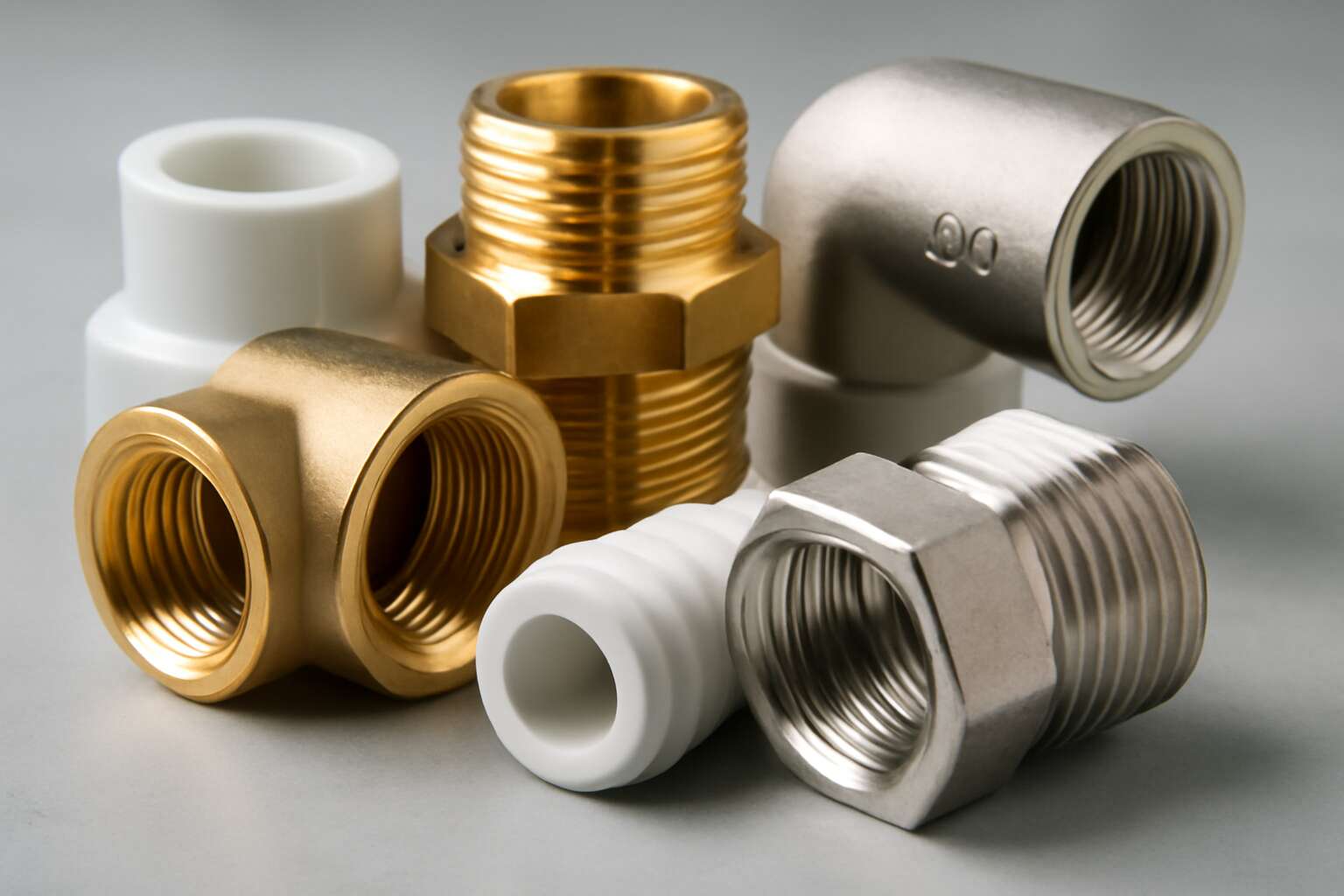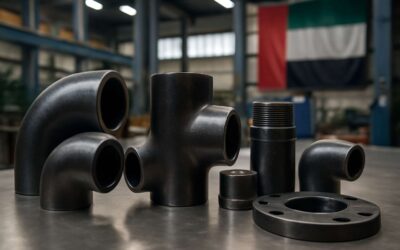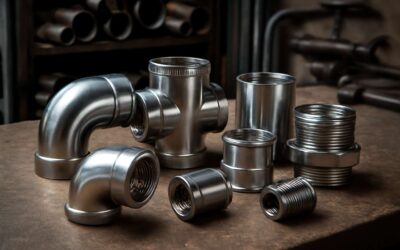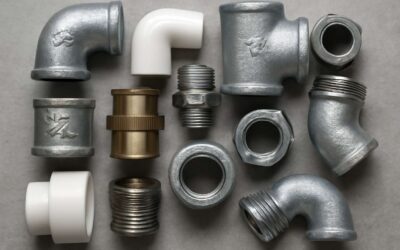Types of Pipe Fitting Materials
Metal-Based Pipe Fitting Materials – Array
Metal-based pipe fitting materials have long been the backbone of reliable plumbing and industrial systems, standing the test of time with their resilience and strength. These materials are renowned for their durability, resistance to high pressure, and ability to withstand extreme temperatures, making them ideal for a broad spectrum of applications. When selecting a pipe fitting material name, engineers and builders often turn to metals like stainless steel and brass, each offering unique benefits.
Stainless steel, for example, is celebrated for its corrosion resistance and aesthetic appeal, making it a favourite in both commercial and residential settings. Brass fittings, on the other hand, are valued for their excellent machinability and natural antimicrobial properties. For those seeking versatility, copper remains a popular choice due to its exceptional thermal conductivity and ease of installation. Here are some common types of metal-based pipe fitting materials:
- Stainless steel
- Brass
- Copper
- Cast iron
Each pipe fitting material name carries its own set of advantages, tailored to meet the demanding needs of modern plumbing and industrial systems. The choice of material often hinges on factors like environmental exposure, pressure requirements, and longevity expectations, transforming simple fittings into critical components of infrastructure. The world of pipe fitting materials is vast and fascinating, blending science with craftsmanship in every connection.
Plastic Pipe Fitting Materials – Array
Plastic pipe fitting materials have revolutionised plumbing with their lightweight, corrosion-resistant, and cost-effective properties. In a world where traditional metals often steal the spotlight, plastics quietly dominate many modern piping projects, offering versatile solutions that are both durable and easy to install. The pipe fitting material name associated with these marvels includes a variety of polymers, each tailored for specific environments and demands.
Popular choices include PVC, CPVC, PPR, and PE, which are renowned for their chemical resistance and flexibility. For instance, PVC is the go-to for drainage and vent systems, thanks to its affordability and ease of fabrication. Meanwhile, CPVC can handle higher temperatures, making it suitable for hot water applications. PPR pipes, with their excellent thermal stability, are often seen in radiant heating systems. Together, these pipe fitting material names exemplify the rich diversity of plastics in piping, proving that sometimes, the future is made of polymer rather than metal.
Once you get familiar with these pipe fitting material names, you’ll see how they contribute to safer, more efficient infrastructure. Whether it’s a building’s water supply or industrial fluid transport, plastics bring a level of adaptability that metals simply can’t match. And with each pipe fitting material name, there’s a story of innovation waiting to be told!
Composite and Specialty Materials – Array
Venture beyond the familiar and you’ll find an intriguing world of composite and specialty pipe fitting materials, each crafted for unique challenges and environments. These materials often blend multiple properties to deliver exceptional performance, making them indispensable in complex piping systems. Their innovative nature often sparks the imagination—imagine pipes that can withstand extreme temperatures or resist aggressive chemicals, all thanks to specialised compositions.
Among these, composite materials such as fiberglass-reinforced plastics (FRP) and hybrid composites stand out. They combine the strength of composites with the flexibility demanded by intricate installations. For example, FRP pipes are celebrated for their remarkable corrosion resistance, making them ideal for chemical plants or offshore platforms. Meanwhile, specialty materials like PVDF (polyvinylidene fluoride) offer high purity and stability in pharmaceutical or food processing environments.
In the realm of pipe fitting material names, these composite and specialty choices often carry distinctive designations, reflecting their advanced features:
- FRP (Fibreglass Reinforced Polymer)
- PVDF (Polyvinylidene Fluoride)
- PVDF composites
- PTFE (Polytetrafluoroethylene)
- PEEK (Polyetheretherketone)
These specialised materials expand the possibilities for engineers and installers, offering solutions that combine durability with specialised chemical or thermal properties. The pipe fitting material name in this category hints at innovation, often promising a blend of resilience and adaptability that metals alone cannot achieve. Such materials are the silent heroes in high-stakes environments, ensuring safety and longevity in the most demanding applications.
Common Properties of Pipe Fitting Materials
Corrosion Resistance – Analyzing how different materials resist corrosion in various environments
Corrosion resistance remains one of the most crucial properties when selecting a pipe fitting material name, especially in environments prone to moisture, chemicals, or extreme pH levels. Different materials respond uniquely to these conditions, which can significantly impact the longevity and safety of piping systems. For instance, certain plastics like PVC and CPVC are renowned for their exceptional corrosion resistance, making them ideal in water treatment plants and chemical industries. On the other hand, some metals, such as stainless steel, contain alloying elements that offer formidable resistance against rust and degradation.
Understanding how each pipe fitting material name performs under specific environmental stresses helps avoid costly repairs and replacements. To illustrate, the following list highlights common materials known for their corrosion resistance:
- Stainless steel – resistant to rust and chemical corrosion
- CPVC and PVC – impervious to many acids and alkalis
- Bronze and brass – resistant to seawater environments
Choosing the right pipe fitting material name for your project means weighing these properties carefully. When corrosion resistance is paramount, the material’s ability to withstand the particular corrosive elements in your environment can determine the success and durability of your piping system. It’s a decision that blends science with practicality, ensuring your systems remain resilient for years to come.
Temperature Tolerance – Understanding the heat resistance of different pipe fitting materials
Temperature tolerance is a critical factor when selecting a pipe fitting material name, especially in environments subject to extreme heat or cold. Materials that can withstand fluctuating temperatures without degrading are vital for maintaining system integrity. For instance, plastics like PVC and CPVC excel in moderate to high temperatures, but their performance diminishes rapidly beyond certain thresholds. Conversely, metals such as cast iron and stainless steel exhibit remarkable heat resistance, allowing them to perform reliably under intense thermal stress.
Understanding the heat resistance of different pipe fitting materials is essential—imagine a system exposed to sudden temperature spikes or prolonged high temperatures. In such cases, the material’s ability to retain its structural properties can make or break the longevity of the piping system. The following list highlights some of the most temperature-tolerant options:
- Stainless steel – excellent at withstanding high temperatures without losing strength
- Cast iron – renowned for durability in hot water and steam applications
- PTFE (Polytetrafluoroethylene) – known for its chemical inertness and high heat resistance
Choosing the right pipe fitting material name based on temperature tolerance is not just about avoiding failure; it’s about ensuring safety and efficiency for years to come. The right material will resist thermal expansion and contraction, preventing leaks and maintaining flow integrity—crucial in demanding industrial settings. When considering your project, remember: the heat resilience of your pipe fitting material name can be the thin line between resilience and catastrophe!
Chemical Compatibility – Matching materials with the chemicals they can withstand
In the intricate dance of piping systems, chemical compatibility often dictates the longevity and safety of the installation. The right pipe fitting material name must harmonise seamlessly with the chemicals it encounters, resisting degradation and ensuring uninterrupted flow. When selecting a pipe fitting material, understanding its chemical resilience is not merely prudent—it is essential. The wrong choice can lead to catastrophic failures, leaks, and costly downtime.
Materials like PTFE (Polytetrafluoroethylene) stand out for their exceptional chemical inertness, making them ideal for aggressive substances. Conversely, plastics such as PVC may excel in certain environments but falter when exposed to strong acids or solvents. It’s important to recognise that each pipe fitting material name carries its unique suite of properties—some withstand caustic chemicals, while others are better suited for neutral fluids.
Consider these common properties of pipe fitting materials in relation to chemical compatibility:
- Resistance to corrosion caused by acids, alkalis, or solvents
- Ability to maintain structural integrity in aggressive environments
- Minimal permeability to prevent chemical seepage
Matching the pipe fitting material name with the chemicals it will contact is a delicate yet vital task—one that can spell the difference between enduring performance and premature failure. It’s a testament to the artistry behind choosing the appropriate material, a choice that sustains not just the integrity of the system but the safety of those who rely on it.
Durability and Longevity – Evaluating the lifespan of each material under typical conditions
In the silent symphony of infrastructure, the durability and longevity of a pipe fitting material name determine whether a system endures or falters. Materials crafted for resilience withstand the relentless forces of time and environment, transforming fleeting installations into steadfast fixtures of progress. The true measure lies in their ability to resist wear, fatigue, and external stressors—ensuring seamless operation over decades.
Every pipe fitting material name bears its own story of endurance, shaped by the environment in which it performs. For example, some materials are engineered to brave the extremes of temperature, while others excel in resisting chemical degradation. The choice hinges on evaluating how each material withstands typical conditions—be it constant pressure, thermal fluctuations, or exposure to corrosive agents. When selecting the perfect fit, understanding its inherent durability becomes the cornerstone of sustainable piping systems.
Ease of Installation – Considering the installation requirements for each material
In the intricate dance of piping systems, ease of installation often determines whether a project glides smoothly or stalls in frustration. When considering the right pipe fitting material name, the simplicity with which it can be fitted plays a pivotal role. Some materials, like certain plastics, are celebrated for their lightweight nature and straightforward assembly, making them a favourite among installers eager to save time and effort.
Conversely, metal-based pipe fitting materials, while robust, may demand specialised tools and a more precise touch—an investment that can extend installation times but pays dividends in durability. For those seeking a seamless experience, materials that require minimal preparation and are compatible with standard fittings are invariably preferred. After all, the true elegance of a well-chosen pipe fitting material name lies in its ability to marry resilience with practicality, transforming complex installations into a testament to engineering finesse.
Applications of Different Pipe Fitting Materials
Residential Plumbing – Suitable materials for household water supply systems
In the quiet corners of many homes, where water flows seamlessly through pipes, the choice of pipe fitting material name can make all the difference. For residential plumbing, selecting the right material ensures not only the safety of drinking water but also the longevity of the entire system. Whether it’s the warmth of copper or the versatility of PEX, each pipe fitting material name carries unique benefits suited for household water supply systems.
For instance, copper fittings are renowned for their durability and natural antimicrobial properties, making them a popular choice in traditional homes. On the other hand, modern plastic options like PEX and PVC have gained popularity due to their ease of installation and resistance to corrosion. When considering the applications of different pipe fitting materials in residential plumbing, it’s essential to evaluate factors such as flexibility, cost, and ease of maintenance. Sometimes, a simple list can clarify choices—such as:
- Copper – ideal for long-lasting, reliable water supply lines.
- PEX – flexible, cost-effective, and quick to install.
- PVC – great for drain, waste, and vent systems due to its chemical resistance.
Choosing the right pipe fitting material name ultimately depends on the specific needs of each household, ensuring that every drop of water flows safely and efficiently through the home’s lifeline. This intricate decision impacts daily life more than many realise, weaving through the very fabric of our routines with quiet resilience.
Industrial Applications – Materials used in manufacturing plants, chemical processing, and more
In the bustling realm of industrial manufacturing, where precision and resilience are paramount, selecting the appropriate pipe fitting material name can spell the difference between seamless operations and costly downtime. Manufacturing plants, chemical processing facilities, and power stations demand materials that can withstand not just the corrosive nature of certain chemicals but also extreme temperatures and mechanical stresses. The choice of pipe fitting material name in such environments is no trivial matter—here, a misstep can lead to compromised safety, environmental hazards, or operational inefficiencies.
Materials such as stainless steel, for their renowned corrosion resistance and robust durability, often take centre stage in these demanding settings. Alternatively, specialised plastics like PTFE or PVDF are employed where chemical inertness is crucial. For example, in chemical processing plants, the chemical compatibility of the pipe fitting material name is scrutinised meticulously, ensuring resistance to aggressive solvents and acids. Conversely, heavy-duty applications might leverage composite materials that blend the strengths of metals and plastics for enhanced performance.
- Stainless Steel – valued for its corrosion resistance and temperature tolerance.
- High-Performance Plastics – such as PTFE, suitable for aggressive chemicals.
- Composite Materials – offering a tailored balance of strength and chemical resistance.
Ultimately, the selection of a pipe fitting material name in industrial applications hinges on a nuanced understanding of operational demands and environmental factors, transforming the mundane task of pipe fitting into a strategic choice vital for safety and longevity. Because in the world of manufacturing, the right material can be the unsung hero ensuring every process flows flawlessly.
Agricultural Uses – Materials appropriate for irrigation and water management systems
In the realm of agriculture, water management is the silent backbone of progress. The choice of a pipe fitting material name can determine whether life-giving irrigation systems function seamlessly or succumb to premature failure. Materials suitable for these applications must endure constant exposure to moisture, soil, and varying weather conditions without compromising integrity.
For irrigation and water distribution networks, plastics like PVC and HDPE often take precedence. Their chemical inertness and flexibility make them ideal for long-term use, resisting the corrosive elements found in natural environments. Additionally, the lightweight nature of these materials simplifies installation, reducing labour costs and downtime.
- Corrosion resistance
- Ease of installation
- Cost-effectiveness
When selecting a pipe fitting material name for agricultural purposes, durability and adaptability are paramount, ensuring that every drop of water reaches its intended destination without loss or contamination. The right material becomes more than just a component—it’s an unspoken promise of sustainable growth and resilience in a world increasingly thirsty for efficiency.
Oil and Gas Industry – Specialized materials designed for high pressure and corrosive environments
In the high-stakes world of oil and gas extraction, selecting the right pipe fitting material name can mean the difference between operational efficiency and costly downtime. These environments demand materials that can withstand extreme pressures and resist aggressive corrosive elements. Steel alloys such as carbon steel and stainless steel are often the go-to choices, thanks to their exceptional strength and corrosion resistance.
For highly corrosive environments, specialised materials like duplex stainless steel or nickel-based alloys are frequently utilised. Their ability to endure harsh chemicals and high temperatures makes them indispensable in complex projects. Additionally, composite materials are increasingly gaining traction for their lightweight yet durable characteristics, providing a practical alternative for challenging conditions.
Ultimately, the choice of a pipe fitting material name in the oil and gas industry hinges on its capacity to endure demanding conditions without compromising safety or performance.
Fire Protection Systems – Materials with fire-resistant properties
In the realm of fire protection systems, the selection of a pipe fitting material name becomes a matter of life and safety. These materials must possess an innate resilience, standing as silent guardians against the destructive force of flames. Fire-resistant pipe fittings, often crafted from specialised metals or composites, serve as critical arteries in buildings and industrial complexes, where the threat of fire lurks like an ever-present shadow.
Materials such as bronze, cast iron, and certain stainless steel alloys are renowned for their exceptional ability to withstand high temperatures, ensuring that the integrity of the system remains uncompromised under extreme conditions. For added security, fire-resistant coatings and intumescent layers are sometimes applied, transforming ordinary pipe fitting material names into heroes of resilience.
In essence, choosing the right pipe fitting material name for fire protection systems is not merely a matter of compliance but a profound commitment to safeguarding lives and property. Each material, with its unique properties and capabilities, weaves a protective tapestry that stands firm amid chaos, exemplifying strength and endurance in the face of peril.
Environmental and Safety Considerations
Eco-Friendly Materials – Sustainable options and their benefits
Environmental and safety considerations are increasingly shaping the landscape of pipe fitting material choices. Eco-friendly materials are gaining traction, not just for their reduced environmental footprint but also for their long-term economic benefits. Sustainable options such as recycled plastics, bio-based composites, and low-impact ceramics offer a compelling alternative to traditional materials. These eco-friendly materials help minimise waste, conserve resources, and lower greenhouse gas emissions, making them an essential part of modern infrastructure development.
Incorporating environmentally conscious pipe fitting material names into projects aligns with global efforts to promote sustainability. For example, using recycled polypropylene not only reduces plastic waste but also ensures chemical stability and durability. These materials often boast benefits like lower energy consumption during manufacturing and ease of recycling at the end of their lifespan. Moreover, selecting such options can contribute to certifications like LEED, which recognise environmental stewardship and sustainable design principles.
Ultimately, choosing sustainable pipe fitting material names underscores a commitment to safety and environmental responsibility. It’s a step towards resilient infrastructure that respects ecological boundaries while meeting industry standards. The shift towards eco-friendly materials isn’t just a trend—it’s an imperative for future-proofing our water, gas, and chemical systems against the mounting pressures of environmental change.
Toxicity and Water Safety – Materials safe for drinking water and potability
In the quest for safe and sustainable infrastructure, selecting the right pipe fitting material name is paramount—especially when water safety and toxicity are at stake. Every year, countless millions rely on the integrity of their piping systems to deliver potable water free from harmful contaminants. When choosing pipe fitting materials, ensuring they meet stringent safety standards is essential to prevent leaching of toxic substances into drinking water. Materials such as high-grade PEX (cross-linked polyethylene) or certain types of PVC (polyvinyl chloride) are renowned for their chemical stability and potability, making them ideal choices in water supply systems.
It’s crucial to understand that not all materials are created equal. Some, like certain composites or older metal alloys, may pose risks if they corrode or degrade over time. For this reason, environmentally conscious projects often prefer pipe fitting material names that explicitly specify their safety credentials—such as compliance with NSF/ANSI standards—ensuring water remains pure and safe. The integrity of these materials is vital, not just for the health of end-users but also for maintaining the longevity of the entire plumbing infrastructure.
Recycling and Disposal – End-of-life considerations for pipe fitting materials
In the silent symphony of infrastructure, each note matters—especially when it comes to end-of-life considerations for pipe fitting material names. The journey of these materials does not end when installation is complete; instead, their environmental footprint echoes long after the first water flows. Recycling and disposal become vital acts of stewardship, ensuring that each pipe fitting material name chosen aligns with the principles of sustainability and ecological responsibility.
Some materials, like certain plastics, lend themselves to recycling, transforming into new components or even repurposed products. Conversely, metal-based pipe fitting materials demand careful handling, as improper disposal can lead to environmental contamination. To navigate this complex terrain, industry standards now advocate for environmentally conscious choices—materials that can be reclaimed or safely decommissioned without releasing toxins into the earth or water.
In this dance of sustainability, understanding the end-of-life fate of a pipe fitting material name is paramount. Here’s a quick overview of common disposal considerations:
- Recycling facilities capable of processing high-grade plastics such as PEX or PVC are essential for reducing landfill burden.
- Metal fittings, often composed of copper or brass, should be sorted and sent to specialised metal recyclers to reclaim valuable resources.
- Composite materials, blending different substances, pose a greater challenge—they may require specialised dismantling procedures or, in some cases, safe disposal as hazardous waste.
Choosing eco-friendly materials with known recycling pathways not only preserves the planet but also safeguards future generations from the toxic legacy of improper disposal. Every pipe fitting material name carries with it a responsibility—an unspoken promise of environmental integrity that must be honoured with conscientious end-of-life practices. After all, the true measure of a sustainable system is how gracefully it concludes its cycle, leaving behind nothing but clean water and a healthier Earth.
Choosing the Right Pipe Fitting Material
Factors to Consider – Pressure, temperature, chemical exposure, budget
Choosing the right pipe fitting material name isn’t just a matter of picking something shiny and hoping for the best. It’s about balancing a delicate act of factors that can make or break your project—think pressure, temperature, chemical exposure, and budget.
Pressure tolerance is paramount; some materials can withstand high-pressure environments like a champ, while others buckle under stress. Temperature plays a similarly crucial role—certain pipe fitting materials excel in high-temperature settings, ensuring your system doesn’t melt down like a popsicle in the sun. Chemical exposure is another critical factor—if your pipes will face corrosive substances, selecting the appropriate pipe fitting material name that resists chemical attack can extend your system’s lifespan significantly.
Budget considerations often shape the decision-making process, but sacrificing quality for savings might cost you more in the long run. So, whether you’re eyeing durable metals, versatile plastics, or eco-friendly options, understanding these core factors ensures your choice is spot-on. After all, a pipe fitting isn’t just a connector; it’s the backbone of your entire plumbing symphony!
Compliance and Standards – Industry certifications and standards to look for
Selecting a suitable pipe fitting material name isn’t just about meeting functional needs—it’s about aligning with rigorous industry standards and certifications that guarantee safety and reliability. In a landscape where compliance can make or break a project, recognising the importance of recognised standards such as ISO, ASTM, or DIN is essential. These benchmarks set the foundation, ensuring your chosen pipe fitting material name adheres to strict quality controls and safety protocols.
For professionals navigating complex systems, verifying certifications like the American Society of Mechanical Engineers (ASME) or the British Standards Institution (BSI) can provide peace of mind. These industry certifications serve as a testament to the material’s performance, durability, and safety credentials. Remember, a pipe fitting material name that aligns with recognised standards isn’t just a label—it’s a safeguard against future failures and costly repairs.
Cost Analysis – Balancing cost with durability and performance
In the realm of pipe fitting material name selection, balancing cost with durability and performance is akin to navigating a vast, enchanted forest where every step must be measured and deliberate. The cost of materials often dictates the boundaries of a project’s scope, yet it is the enduring strength and resilience that determine long-term success. For many professionals, the true magic lies in discovering a material that offers the perfect harmony between affordability and reliability.
While budget constraints are a reality, choosing a pipe fitting material name that guarantees longevity can save a fortune in future repairs and replacements. It’s essential to weigh initial investment against the potential for wear and corrosion over time. Sometimes, investing a little more in a high-performance material can transform a fragile system into an enduring conduit of progress, resisting the ravages of time, chemicals, and extreme temperatures.
To aid this quest, consider an ordered approach: evaluate the specific environmental conditions, chemical exposure, and pressure requirements your project demands. This process ensures that the chosen pipe fitting material name is not just a label but a badge of resilience, safeguarding the infrastructure’s future and cementing its place in the annals of engineering excellence.




0 Comments